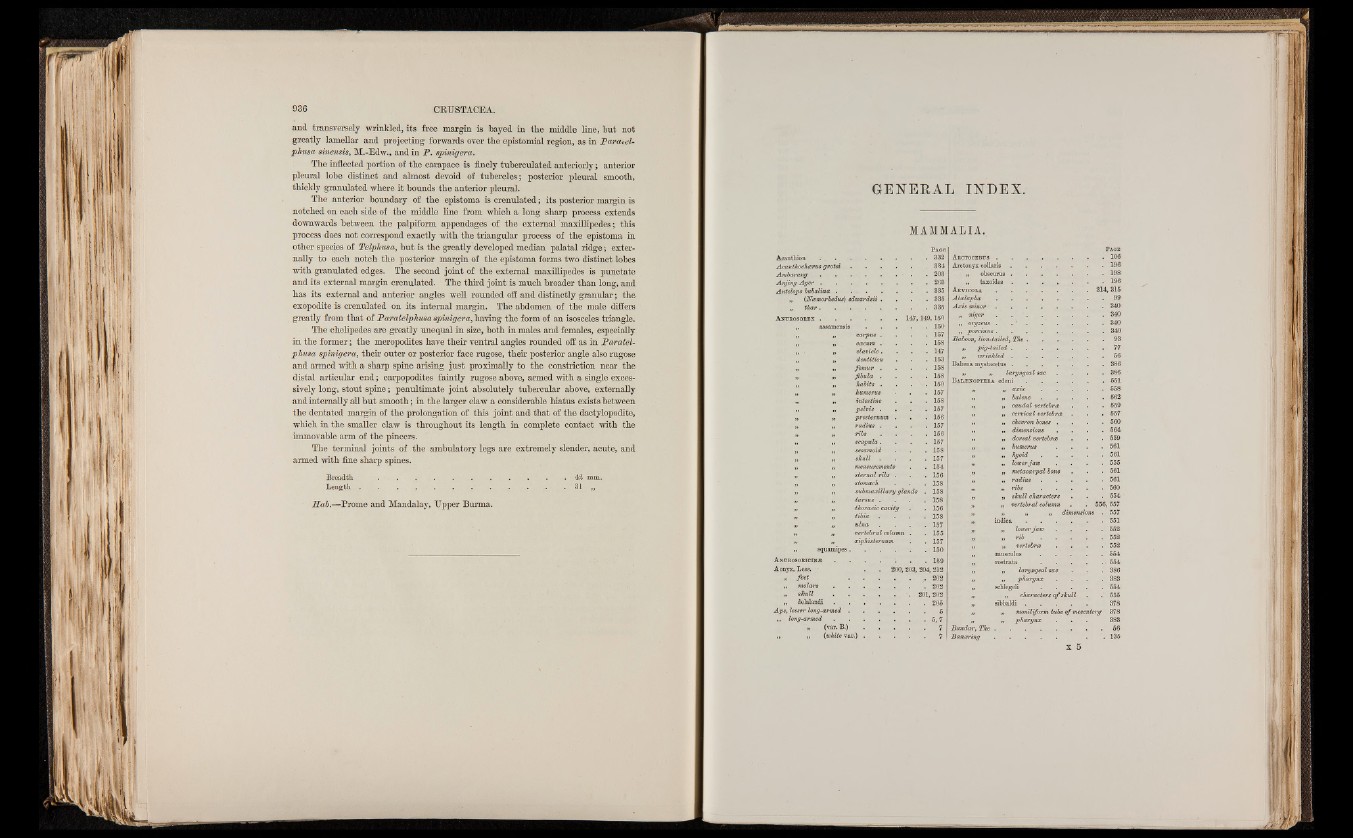
and transversely wrinkled, its free margin is bayed in the middle line, but not
greatly lamellar and projecting forwards over the epistomial region, as in Paratdl-
pliusa sinensis, M.-Edw., and in P. spmigera.
The inflected portion of the carapace is finely tuberculated anteriorly; anterior
pleural lobe distinct and almost devoid of tubercles; posterior pleural smooth,
thickly granulated where it bounds the anterior pleural.
The anterior boundary of the epistoma is crenulated; its posterior margin is
notched on each side of the middle line from which a long sharp process extends
downwards between the palpiform appendages of the external maxillipedes; this
process does not correspond exactly with the triangular process of the epistoma in
other species of Telphusa, but is the greatly developed median palatal ridge; externally
to each notch the posterior margin of the epistoma forms two distinct lobes
with granulated edges. The second joint of the external maxillipedes is punctate
and its external margin crenulated. The third joint is much broader than long, and
has its external and anterior angles well rounded off and distinctly granular; the
exopodite is crenulated on its internal margin. The abdomen of the male differs
greatly from that of Paratelphusa spmigera, having the form of an isosceles triangle.
The chelipedes are greatly unequal in size, both in males and females, especially
in the former; the meropodites have their ventral angles rounded off as in Paratel-
phusa spmigera, their outer or posterior face rugose, their posterior angle also rugose
and armed with a sharp spine arising just proximally to the constriction near the
distal articular end; carpopodites faintly rugose above, armed with a single excessively
long, stout spine; penultimate joint absolutely tubercular above, externally
and internally all but smooth; in the larger claw a considerable hiatus exists between
the dentated margin of the prolongation of this joint and that of the dactylopodite,
which in the smaller claw is throughout its length in complete contact with the
immovable arm of the pincers.
The terminal joints of the ambulatory legs are extremely slender, acute, and
armed with fine sharp spines.
B r e a d t h .......................................................................................................42 mm.
Length . . . ! . . . . . . . . 81 ,,
Sab.—Prome and Mandalay, Upper Burma.
GENERAL INDEX.
MAMMALIA.
P age
Acamthocharus grotei . 334
Ambarang . .
Anjivg Ayer . . 203
Antelope bvbalina . . 335
„ (Namorhedus) edwardsii . . 335
„ t h a r . . 335
Anubosobex . . . . . 1 4 7 149,150
„ assamensis . 150
carpus . . 157
cacum . . 158
clavicle . . 147
dentition . 153
femur . . 158
fibula . . 158
habits . A . 150
humerus . 157
intestine . 168
pelvis . . . 157
prestemum . . 156
radius . . . 157
ribs ¿ 156
scapula. . 157
sesamoid . • . 158
skull . 157
measurements . 154
sternal ribs . . 156
stomach . 158
submaxillary glands . 158
tarsus . . 158
thoracic cavity . 156
• 1 ' ■»» ' » tibia . 158
ulna . 157
vertebral column . . 155
xiphistemum . 157
„ squamipes. . 150
ANUEOSOBICINiE . 159
Aonyx, Less. . 200, 203,204,212 ,
„ feet .. 202
' „ molars . . . 202
skull 201, 202
„ delalandi . 205
Ape, lesser long-armed . 5
„ long-armed
' ,, (var. B.) 7
„ ■ „ (white var.) . . . . 7
Faob
Aectocebtts.................................................................106
Arctonyx c o l l a r i s .................................................. . 196
ly'. obscurus . . . . . . . 198
e „ t a x o i d e s ....................................................... 196
A e t i c o l a ........................................................... 314,315
A t a l a p h a ..................................................................99
A x is minor . . . . . . . . 340
„ n i g e r .................................................................340
' . .» oryzeus . . ' . . . . . 340
„ porcimus. .................................................. . 340
Baboon, lion-tailed, The . . . . . . 9 3
» pig-tailed . 77
, w r in k l e d ........................................................ 66
Balasna m ystacetus....................................................... 386
,, ,, laryngeal sac . . . . 386
Balsnopteea e d e n i ...................................................... 651
,, „ axis . . . . 558
„ „ balene . . . . . 562
,, „ caudal vertebra . . . 659
„ „ cervical vertebra . . • 657
„ „ chevron bones . . . . 660
„ „ dimensions . . . . 564
„ „ dorsal vertebra . • . 559
„ „ humerus . . . . 561
n ,, hyoid . . . . . 561
„ „ lower jaw . . . . 555
„ „ metacarpal bone . . . 561
„ „ r a d i u s .............................................561
„ » ribs . . . . . 660
„ „ sku ll characters . . . 554
„ „ vertebral column . . 556,557
„ „ „ „ dimensions . 557
i, i n d i c a ...................................................... 551
„ „ lower ja w . . . . 552
„ „ r i b .............................................552
„ „ vertebra . . . . 552
,, mnsculus . . . . . 554
„ rostrata ............................................. 554
„ „ laryngeal sac . . . 386
„ „ pharynx . . . . 383
„ scblegeli . . . . . 554
: „ characters o f sku ll . . 555
„ 8ibbaldi . . . . . 378
„ „ moniliform tube o f mesentery 378
„ ,,. pharynx . . . 383
Bandar, T h e ............................................................................ 56
B a n x r i n g . . 135
x 5